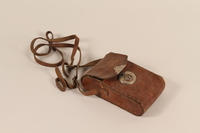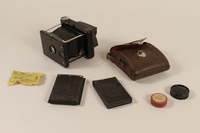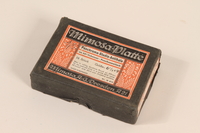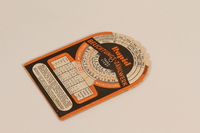Overview
- Brief Narrative
- German gas cape pouch found by Sergeant Walter E. Hunkler, medical technician, 160th Field Artillery Battalion, 45th Infantry Division, known as the Thunderbirds, from June 1943 to September 1945. The pouch was worn on a German soldier’s chest, attached to gas mask pouch shoulder strap. Walter may have used it to hold binoculars. In July 1943, Walter entered combat in Sicily and then advanced with his unit through Italy, France, and Germany. Walter’s unit was with the 157th Infantry when, on April 29, they arrived with the 45th Infantry at and liberated Dachau concentration camp in Germany. There were nearly 30,000 starving and dying prisoners in need of aid. Walter photographed the camp and prisoners with one of the two cameras that he carried. Walter’s Dachau photographs are part of this collection, 2000.526.1. Walter was awarded a Bronze Star for bravery while tending the wounded.
- Date
-
found:
after 1943 June-1945
manufacture: 1942
- Geography
-
manufacture:
Germany
- Credit Line
- United States Holocaust Memorial Museum Collection, Gift of Roberta E. Hunkler
- Markings
- interior, top flap, stenciled, white paint : gek / R1/42
interior, top flap, snap sockets, engraved : PRYM - Contributor
-
Subject:
Walter E. Hunkler
- Biography
-
Walter Eugene Hunkler was born on February 8, 1915, in Washington, Illinois. He was the second of two children born to John and Bertha Geiger Hunkler. His parents were born in Switzerland and immigrated to the United States. John was a teamster and day laborer. Walter graduated from high school and became a bartender. He married and had a child, but later divorced.
After the December 7, 1941, Japanese attack on Pearl Harbor, Germany declared war on the US and a few days later America entered World War II. On January 19, 1942, Walter was drafted into the US Army. Walter became a medical technician, assigned to a medical detachment, 160th Field Artillery Battalion, 45th Infantry Division, nicknamed the Thunderbird Division. In June 1943, the Division was deployed to Europe. Walter went into combat that July in Sicily, Italy. As the Division advanced through Italy and France, Walter participated in several campaigns: Anzio, Rome-Arno, Southern France, and Ardennes-Alsace-Battle of the Bulge. In spring 1945, the Division advanced into Germany. Walter’s unit was operating with the 157th Infantry when, on April 29, 1945, the 45th Infantry liberated Dachau concentration camp in Germany. They discovered over 30,000 survivors in the camp and 2,310 corpses on a train. Walter witnessed and photographed atrocities, the horrible camp conditions, and the surviving inmates. Following Germany’s May 7 surrender, the 45th Infantry was stationed near Dachau. Walter returned to the US in September 1945, and was honorably discharged as a Technician Fourth Grade in October. He was deployed overseas for 691 Days; 511 of them in combat. He received a Bronze Star for bravery for risking his own safety while tending to the wounded, as well as many battle stars for campaigns where his unit fought.
Walter returned to Washington, Illinois, and worked for the Central Illinois Light Company. In October 1956, Walter married Roberta Leighton (1916 – 2007). Walter did not speak about his wartime experiences. Only once, in 1947, did he allow Roberta to see the photographs he took at Dachau before sealing them inside a storage container where they remained for over fifty years. Walter, 76, died on September 8, 1991, in Peoria, Illinois.
Physical Details
- Classification
-
Containers
- Category
-
Bags
- Object Type
-
Pouches (Containers) (lcsh)
- Physical Description
- Rectangular, dark gray, coated cloth pouch with rounded ends, narrow side panels, and an overlapping top flap with a straight edge and angled corners. The flap has 2 dark gray painted snap caps sewn over short canvas strips for 2 silver colored snap studs on the front; both snap sets have interior reinforcing canvas strips. The exterior corners are reinforced with square patches. The back has 2 short canvas strips with interior strips sewn horizontally to the top and bottom.
- Dimensions
- overall: Height: 8.750 inches (22.225 cm) | Width: 6.500 inches (16.51 cm)
- Materials
- overall : cloth, canvas, metal, thread, paint
Rights & Restrictions
- Conditions on Access
- No restrictions on access
- Conditions on Use
- No restrictions on use
Keywords & Subjects
Administrative Notes
- Legal Status
- Permanent Collection
- Provenance
- The pouch was donated to the United States Holocaust Memorial Museum in 2000 by Roberta E. Hunkler, on behalf of the Estate of her husband, Walter E. Hunkler.
- Funding Note
- The cataloging of this artifact has been supported by a grant from the Conference on Jewish Material Claims Against Germany.
- Record last modified:
- 2023-08-25 16:40:44
- This page:
- https://collections.ushmm.org/search/catalog/irn513199
Download & Licensing
In-Person Research
- By Appointment
- Request 21 Days in Advance of Visit
- Plan a Research Visit
- Request to See This Object
Contact Us
Also in Walter E. Hunkler collection
The collection consists of two cameras, camera accessories, a cloth pouch, documents, and photographs relating to the experiences of Walter E. Hunkler, medical technician, 160th Field Artillery Battalion, 45th Infantry Division, United States Army in combat in Europe during World War II, including the liberation of Dachau concentration camp in Germany.
Date: 1942-1945 August

Six-20 Kodak camera and accessories used by US soldier
Object
Kodak Six-20 camera with art deco styling used by Sergeant Walter E. Hunkler, medical technician, 160th Field Artillery Battalion, 45th Infantry Division, known as the Thunderbirds from June 1943 to September 1945. This folding bellows camera was a portable model that took eight large 2 ¼ x 3 ¼ inch shots on a single no. 620 film roll. In July 1943, Walter entered combat in Sicily and then advanced with his unit through Italy, France, and Germany. Walter’s unit was with the 157th Infantry when, on April 29, they arrived with the 45th Infantry at and liberated Dachau concentration camp in Germany. There were nearly 30,000 starving and dying prisoners in need of aid. Walter photographed the camp and prisoners with one of the two cameras that he carried. Walter’s Dachau photographs are part of this collection, 2000.526.1. Walter was awarded a Bronze Star for bravery while tending the wounded.

Goerz Tenax pocket camera and accessories used by US soldier
Object
Goerz Coat Pocket Tenax camera and photographic accessories used by Sergeant Walter E. Hunkler, medical technician, 160th Field Artillery Battalion, 45th Infantry Division, known as the Thunderbirds, from June 1943 to September 1945. In July 1943, Walter entered combat in Sicily and then advanced with his unit through Italy, France, and Germany. Walter’s unit was with the 157th Infantry when, on April 29, they arrived with the 45th Infantry at and liberated Dachau concentration camp in Germany. There were nearly 30,000 starving and dying prisoners in need of aid. Walter photographed the camp and prisoners with one of the two cameras that he carried. Walter’s Dachau photographs are part of this collection, 2000.526.1. Walter was awarded a Bronze Star for bravery while tending the wounded.

Mimosa 6.5 x 9 cm sheet film box used by US soldier
Object
Mimosa sheet film box used by Sergeant Walter E. Hunkler, medical technician, 160th Field Artillery Battalion, 45th Infantry Division, known as the Thunderbirds, from June 1943 to September 1945. The box held 6.5 x 9 cm film sheets which would fit the Tenax camera that he used during the war.In July 1943, Walter entered combat in Sicily and then advanced with his unit through Italy, France, and Germany. Walter’s unit was with the 157th Infantry when, on April 29, they arrived with the 45th Infantry at and liberated Dachau concentration camp in Germany. There were nearly 30,000 starving and dying prisoners in need of aid. Walter photographed the camp and prisoners with one of the two cameras that he carried. Walter’s Dachau photographs are part of this collection, 2000.526.1. Walter was awarded a Bronze Star for bravery while tending the wounded.

Photographic light exposure calculator used by US soldier
Object
Cardboard photographic light meter used by Sergeant Walter E. Hunkler, medical technician, 160th Field Artillery Battalion, 45th Infantry Division, known as the Thunderbirds, from June 1943 to September 1945.In July 1943, Walter entered combat in Sicily and then advanced with his unit through Italy, France, and Germany. Walter’s unit was with the 157th Infantry when, on April 29, they arrived with the 45th Infantry at and liberated Dachau concentration camp in Germany. There were nearly 30,000 starving and dying prisoners in need of aid. Walter photographed the camp and prisoners with one of the two cameras that he carried. Walter’s Dachau photographs are part of this collection, 2000.526.1. Walter was awarded a Bronze Star for bravery while tending the wounded.
Walter Hunkler papers
Document
Contains two documents titled allowing U.S. military officer to possess and/or mail "captured enemy military equipment," retrieved and used by Sergeant Walter Hunkler, dated August 20, 1945. One envelope with "Dachau" written on front and "44." Group of black and white photographs from Dachau, taken by Sergeant Hunkler, and othes gathered in Germany after liberation of the camp. The documents belonged to Walter Hunkler (donor's husband), Sergeant, assigned to medical detachment of the 160th Field Artillery Battalion, a unit of the 45th armored division that entered concentration camp Dachau in Germany on April 29, 1945.



